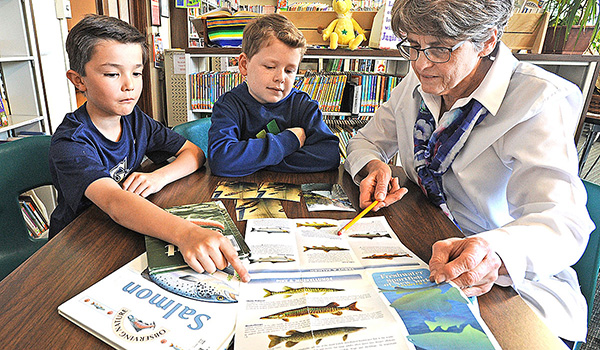Students take STREAM literally with fish in the classroom
by KIMBERLEE SABSHIN
As part of its participation in the diocesan STREAM initiative at local Catholic schools, St. Mary School in Swormville recently opted to take STREAM, usually an acronym standing for science, technology, religion, engineering, art and mathematics, literally. Polly Lougen's third-, fourth- and fifth-grade science classes hatched and raised brown trout eggs and fry (baby fish) in the school's science lab, which the Department of Environmental Conservation later released in Glen Park's Ellicott Creek in Williamsville.
Lougen engaged her students in this activity as part of Trout in the Classroom, an educational initiative for students at the elementary, middle and high school level involving the hands-on raising of brown trout to repopulate native waters, part of projects the DEC usually conducts in order to promote awareness of cold water conservation and the health and maintenance of North American wild fish populations.
"Chuck Godfrey got the permit for us so we could release them," Lougen recalled. "He's the president of Western New York Trout Unlimited, and he also delivered the fish eggs."
Lougen and her husband learned about Trout Unlimited via a story in New York State Conservationist, a magazine the DEC publishes six times per year. "There was an article about raising trout in the classroom, so (my husband) said to me, 'You should read this article. I think you'd be able to do it.' And so I did, and it fit in our curriculum. I thought it was a great idea, and so we did it," Lougen commented.
The Lougens sponsored the project and bought all of the equipment needed to raise cold-water species in an aquarium, including a 55-gallon tank, a canister filter and a chiller. They got the eggs in October, and the fish were in the classroom at St. Mary's until April, when Godfrey came to the school to get them.
Derek Ogiba and Dylan Leong, both fourth-graders in Lougen's class, described what it was like to be able to raise their own fish. "It was fun watching them grow," Derek said. Shortly after the fish hatched, they still had egg sacs attached. Newborn fish are referred to as "alevin" while they are carrying yolk sacs. They had stripes, which changed to spots as they got older, with Dylan noting the largest fish in their tank was the size of his middle finger. Once baby fish are no longer "fry," they are referred to as "fingerlings."
As the fish grew, students not only took observations and measurements of the changes they underwent, but also cleaned the tank, and fed the fish with food the DEC provided once they no longer could receive nourishment from their attached yolk sacs. In the process, students learned that aquariums need regular water changes in order to keep ammonia, which fish produce by excreting waste as well as from uneaten fish food that decays, from building up. If ammonia levels get high, this damages the fishes' gills.
When asked for her opinion on Trout in the Classroom, Lougen, a decorated educator who received the Sister Lucille Socciarelli/Father John Sturm "Making a Difference" Award from the Diocese of Buffalo in January, said, "I thought it gave the children an opportunity to see life at the very beginning. I have had chicken eggs (in the classroom) with them, but this was in the water, so I've never seen a fish egg."
With the exception of Dylan, who had once seen fish eggs on a fishing trip, none of the participants had ever seen them before, so this project gave everyone a chance to see the fish from their earliest stages of development. Dylan said the most important thing he learned about the brown trout was their life cycle. Derek found it interesting that "they have stripes, and then they lose their stripes and get dots."
Gina Charland, advancement director at St. Mary School, said this project and the schools' collaboration with Western New York Trout Unlimited greatly enhanced students' STREAM experience.
"It takes everything into account, every one of those components," she said. "You've got experiential science happening all around them. They're learning about life cycles, they're learning about changes in the environment. They're seeing adaptation, they're seeing the growth and development phases. They would work in technology as well. They have opportunities within the classroom to work on presentations."
Charland continued, "They were looking at different techniques for measuring. Some went back to the basics of even just using a ruler, but then in the recording phase, they would transfer that into their reports that they could use other opportunities and presentations using a Smart Board in the room."




